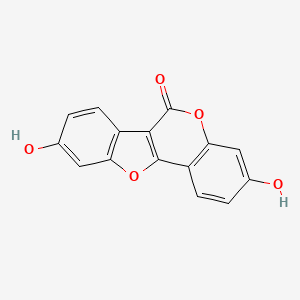| MeSH term | MeSH ID | Detail |
|---|---|---|
| Breast Neoplasms | D001943 | 24 associated lipids |
| Lupus Erythematosus, Systemic | D008180 | 43 associated lipids |
| Pancreatic Neoplasms | D010190 | 77 associated lipids |
| Colonic Neoplasms | D003110 | 161 associated lipids |
| Mammary Neoplasms, Experimental | D008325 | 67 associated lipids |
| Body Weight | D001835 | 333 associated lipids |
| Edema | D004487 | 152 associated lipids |
| Weight Gain | D015430 | 101 associated lipids |
| Endometriosis | D004715 | 29 associated lipids |
| Birth Weight | D001724 | 23 associated lipids |
COUMESTROL
COUMESTROL is a lipid of Polyketides (PK) class. Coumestrol is associated with abnormalities such as Infertility, Renal tubular disorder, Osteoporosis, Postmenopausal, Nodule and Central precocious puberty. The involved functions are known as Process, antagonists, Accident due to exposure to weather conditions, physiological aspects and Cell Proliferation. Coumestrol often locates in Blood, Body tissue, Reproductive system, Membrane and Myometrial. The associated genes with COUMESTROL are GAPDH gene, PPID gene, pyridinoline, NODAL gene and Nitrogen fixation gene. The related lipids are enterodiol. The related experimental models are Mouse Model.
Cross Reference
Introduction
To understand associated biological information of COUMESTROL, we collected biological information of abnormalities, associated pathways, cellular/molecular locations, biological functions, related genes/proteins, lipids and common seen animal/experimental models with organized paragraphs from literatures.
What diseases are associated with COUMESTROL?
COUMESTROL is suspected in Infertility, Renal tubular disorder, Osteoporosis, Postmenopausal, Nodule, Central precocious puberty and other diseases in descending order of the highest number of associated sentences.
Related references are mostly published in these journals:
| Disease | Cross reference | Weighted score | Related literature |
|---|
Possible diseases from mapped MeSH terms on references
We collected disease MeSH terms mapped to the references associated with COUMESTROL
PubChem Associated disorders and diseases
What pathways are associated with COUMESTROL
There are no associated biomedical information in the current reference collection.
PubChem Biomolecular Interactions and Pathways
Link to PubChem Biomolecular Interactions and PathwaysWhat cellular locations are associated with COUMESTROL?
Visualization in cellular structure
Associated locations are in red color. Not associated locations are in black.
Related references are published most in these journals:
| Location | Cross reference | Weighted score | Related literatures |
|---|
What functions are associated with COUMESTROL?
Related references are published most in these journals:
| Function | Cross reference | Weighted score | Related literatures |
|---|
What lipids are associated with COUMESTROL?
Related references are published most in these journals:
| Lipid concept | Cross reference | Weighted score | Related literatures |
|---|
What genes are associated with COUMESTROL?
Related references are published most in these journals:
| Gene | Cross reference | Weighted score | Related literatures |
|---|
What common seen animal models are associated with COUMESTROL?
Mouse Model
Mouse Model are used in the study 'Modulation of tumor formation and intestinal cell migration by estrogens in the Apc(Min/+) mouse model of colorectal cancer.' (Javid SH et al., 2005).
Related references are published most in these journals:
| Model | Cross reference | Weighted score | Related literatures |
|---|
NCBI Entrez Crosslinks
All references with COUMESTROL
Download all related citations| Authors | Title | Published | Journal | PubMed Link |
|---|---|---|---|---|
| Morales-Otal A et al. | Effects of neonatal treatment with two phytoestrogens on male rat sexual behavior and partner preference. | 2016 | Behav Pharmacol | pmid:27482864 |
| Jang YJ et al. | Coumestrol modulates Akt and Wnt/β-catenin signaling during the attenuation of adipogenesis. | 2016 | Food Funct | pmid:27868125 |
| Jin X et al. | Coumestrol inhibits autoantibody production through modulating Th1 response in experimental autoimmune thyroiditis. | 2016 | Oncotarget | pmid:27384679 |
| Bláhová L et al. | Phytoestrogens in milk: Overestimations caused by contamination of the hydrolytic enzyme used during sample extraction. | 2016 | J. Dairy Sci. | pmid:27394955 |
| Zafar A et al. | Cu(II)-coumestrol interaction leads to ROS-mediated DNA damage and cell death: a putative mechanism for anticancer activity. | 2016 | J. Nutr. Biochem. | pmid:27260464 |
| Bianchi SE et al. | A bioanalytical HPLC method for coumestrol quantification in skin permeation tests followed by UPLC-QTOF/HDMS stability-indicating method for identification of degradation products. | 2016 | J. Chromatogr. B Analyt. Technol. Biomed. Life Sci. | pmid:27010353 |
| Lim W and Song G | Stimulatory Effects of Coumestrol on Embryonic and Fetal Development Through AKT and ERK1/2 MAPK Signal Transduction. | 2016 | J. Cell. Physiol. | pmid:26991852 |
| Hu YC et al. | Detection of a negative correlation between prescription of Chinese herbal products containing coumestrol, genistein or daidzein and risk of subsequent endometrial cancer among tamoxifen-treated female breast cancer survivors in Taiwan between 1998 and 2008: A population-based study. | 2015 | J Ethnopharmacol | pmid:25934515 |
| Liu H et al. | Coumestrol inhibits carotid sinus baroreceptor activity by cAMP/PKA dependent nitric oxide release in anesthetized male rats. | 2015 | Biochem. Pharmacol. | pmid:25449602 |
| Hong H et al. | Human sex hormone-binding globulin binding affinities of 125 structurally diverse chemicals and comparison with their binding to androgen receptor, estrogen receptor, and α-fetoprotein. | 2015 | Toxicol. Sci. | pmid:25349334 |
